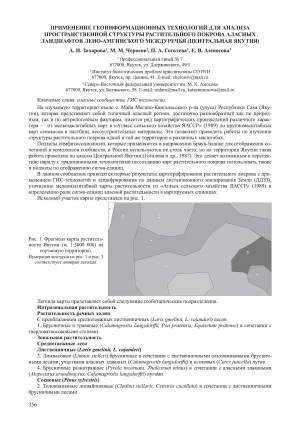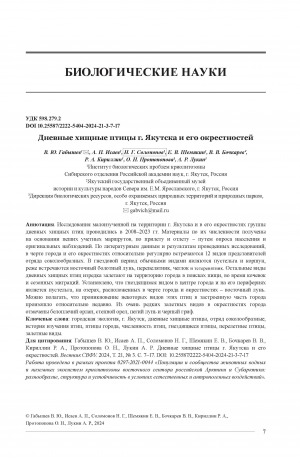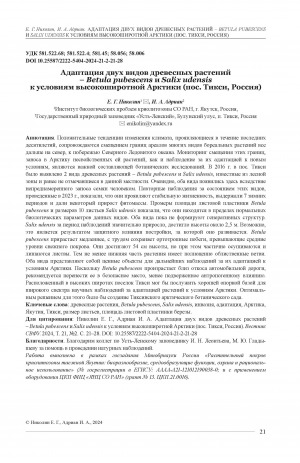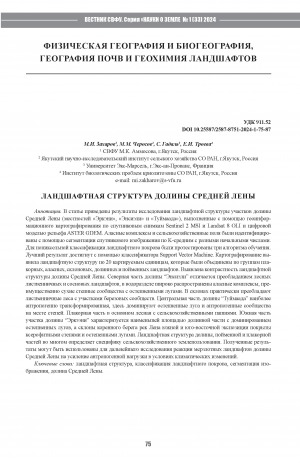Создан в 1951 г. как Институт биологии ЯФ АН СССР, предназначенный для изучения проблем почвоведения, биохимии и физиологии растений, ботаники, зоологии и животноводства. В 1989 г. переименован в Якутский институт биологии СО АН СССР, в 1997 г. в ИБПК СО РАН. Основные направления научной деятельности: экология организмов и сообществ (структурно-динамическая организация, функционирование и устойчивость экосистем криолитозоны); биологическое разнообразие (оптимизация и охрана биологических ресурсов криолитозоны). В структуру института входят 7 научных подразделений: биогеохимических циклов мерзлотных экосистем; ботанический сад; генезиса и экологии почвенно-растительного покрова; зоологических исследований; флористики, геоботаники и мерзлотного лесоведения; экологической и медицинской биохимии, биотехнологии и радиобиологии; экосистемных исследований холодных регионов. Директора: В. П. Дадыкин (1952-1954), Я. Л. Глембоцкий (1954-1957), В. Г. Зольников (1957-1960), В. А. Тавровский (1960-1968), И. П. Щербаков (1968-1986), Н. Г. Соломонов (1986-1997), Б. И. Иванов (1997-2006), П. А. Ремигайло (2007-2017), И. М. Охлопков (с 2017).
Количество страниц: 3 с.
- Математика. Естественные науки > Астрономия. Астрофизика. Исследование космического пространства. Геодезия,
- Прикладные науки. Медицина. Ветеринария. Техника. Сельское хозяйство > Сельское хозяйство. Лесное хозяйство. Охота. Рыболовное хозяйство,
- НАУКА ЯКУТИИ > ПРИКЛАДНЫЕ НАУКИ. МЕДИЦИНА. ТЕХНИКА. СЕЛЬСКОЕ ХОЗЯЙСТВО > Сельское хозяйство. Лесное хозяйство. Охота. Рыболовное хозяйство,
- НАУКА ЯКУТИИ > МАТЕМАТИКА. ЕСТЕСТВЕННЫЕ НАУКИ > Астрономия. Астрофизика. Исследование космического пространства. Геодезия.
Захарова А. И., Черосов М. М., Гоголева П. А., Аммосова Е. В. Применение геоинформационных технологий для анализа пространственной структуры растительного покрова аласных ландшафтов Лено-Амгинского междуречья (Центральная Якутия) // Отечественная геоботаника: основные вехи и перспективы. - 2011. - Т. 1: Разнообразие типов растительных сообществ и вопросы их охраны. География и картография растительности. История и перспективы геоботанических исследований. - С. 356-358.
Количество страниц: 11 с.
The article presents the results of monitoring the vitality of coenopopulations of the meadow grass Agrostis diluta Kurcz. and the steppe grass Psathyrostachys caespitosa (Sukaczev) Peschkova in Central Yakutia. The vitality of the coenopopulations was assessed using the quality index Q and the vitality index of coenopopulations IVC. The studies showed that the vitality structure of the A. diluta and P. caespitosa coenopopulations during 7-16 years of the study is heterogeneous and their vitality is generally unstable. The leading factor influencing the level of vitality of the studied species under mild anthropogenic impact is the water supply of plants during the growing season. In years with unfavourable moisture conditions (high hydrothermal coefficient), the coenopopulations are characterised as depressed, and in conditions of favourable moisture, they quickly transform into a prosperous type. This adaptation characterises these species as species capable of survival and self-sustainment in various ecological and phytocenotic conditions. The state of A. diluta coenopopulations is also affected by spring floods. In dry years, a longer spring flood favours the vitality of populations, while in favourable years it does not favour them. The vitality state of the coenopopulations of both tussock grasses, which differ sharply in their ecological and coenotic characteristics, is also influenced by the features of the mesorelief shape of the floodplain and the slope of the native bank. Comparison of the quality and vitality indices of coenopopulations over the years revealed their correspondence to each other and the same order of decrease when coenopopulations transition from a prosperous to a depressed state.
Кардашевская, В. Е. Мониторинг виталитетного состояния ценопопуляций Agrostis diluta Kurcz. и Psathyrostachys caespitosa (Sukaczev) Peschkovaв Центральной Якутии / В. Е. Кардашевская, Н. Н. Егорова ; Институт биологических проблем криолитозоны, Северо-Восточный федеральный университет им. М. К. Аммосова // Вестник Северо-Восточного федерального университета им. М. К. Аммосова. - 2024. - Т. 21, N 3 (97). - С. 18-28. - DOI: 10.25587/2222-5404-2024-21-3-18-28
DOI: 10.25587/2222-5404-2024-21-3-18-28
Количество страниц: 11 с.
Investigations of a little-studied group of diurnal birds of prey in the territory of Yakutsk and its vicinity were carried out in 2008-2023. The materials on their numbers were obtained on the basis of foot survey routes, on arrival and departure - by interviewing the population and original observations. According to the literature data and the results of the surveys, 12 species of the Falconiformes order are relatively regularly found in the city and its vicinity. Kestrel and kite are common in the breeding period, while the Eastern Harrier, quail, lapwing and grouse are less common. Other species of diurnal birds of prey occasionally visit the city in search of food, during the wanderings and seasonal migrations. Kestrels were found to be nesting in the city centre and on its periphery, Eastern Harrier on lakes located within the city and in the vicinity, and Red-crowned Lapwing on dacha plots. The first nesting of Kestrels in the city was recorded in 1977, Eastern Harrier - several years ago, and Redpoll - in 2021, therefore, it can be assumed that penetration of some species of these birds into the built-up part of the city is relatively recent. Among very rare migratory species, Steller's sea eagle, steppe eagle, harrier and black vulture were recorded in the vicinity of the city.
Дневные хищные птицы г. Якутска и его окрестностей / В. Ю. Габышев, А. П. Исаев, Н. Г. Соломонов, Е. В. Шемякин [и др.] ; Институт биологических проблем криолитозоны, Якутский государственный объединенный музей истории и культуры народов Севера им. Е. М. Ярославского, Дирекция биологических ресурсов, особо охраняемых природных территорий и природных парков // Вестник Северо-Восточного федерального университета им. М. К. Аммосова. - 2024. - Т. 21, N 3 (97). - С. 7-17. - DOI: 10.25587/2222-5404-2024-21-3-7-17
DOI: 10.25587/2222-5404-2024-21-3-7-17
Количество страниц: 6 с.
The frequency of Del 19 and L858R mutations of the EGFR gene was studied among patients of the Yakut Republican Oncology Dispensary with lung adenocarcinoma (n=177). Mutations were found 3.8 times more commonly in female population than in male. Mutations were detected 2.8 times more regularly among patients with stages I and II of the disease in compare with stages III and IV. The mutation frequency was 3.4 times over in the Sakha (Yakut) ethnic group patients as opposed to Russian ethnic group. In addition the mutation frequency was 9.6 times over in the Sakha (Yakut) ethnic group male patients as opposed to Russian ethnic group. It was shown that the overall 36-month survival of patients with a positive status of EGFR mutations increases by 2.5 times (from 29.3% to 74.1%). Moreover in patients with stages I and II of the disease, survival rate increases by 1.4 times, in patients over 65 years old in 2.9 times, in female patients in 2.4 times.
Мутации гена EGFR (DEL19/L858R) при аденокарциноме легкого у пациентов якутского республиканского онкологического диспансера / Михайлов Ю. Н., Филиппов Э. В., Филиппова Г. В., Иванова Ф.Г. [и др.] ; ГБУ РС(Я) "Якутский республиканский онкологический диспансер", Институт биологических проблем криолитозоны, Северо-Восточный федеральный университет им. М. К. Аммосова // Якутский медицинский журнал. - 2024. - N 3 (87). - С. 83-88. - DOI: 10.35789/YMJ.3034.87.17
DOI: 10.35789/YMJ.3034.87.17
Ответственность: Слепцова Снежана Спиридоновна (Составитель), Кершенгольц Борис Моисеевич (Составитель), Колосова Ольга Николаевна (Составитель), Шашурин Михаил Михайлович (Составитель), Николаева Евгения Николаевна (Составитель), Петрова Пальмира Георгиевна (Автор обозрения, рецензии), Татаринова Ольга Викторовна (Автор обозрения, рецензии)
Издательство: Издательство ФГБУН Институт мерзлотоведения им. П. И. Мельникова СО РАН
Год выпуска: 2024
Количество страниц: 28 с.
Биологически активная добавка "Бетукладин" в профилактике дезадаптационных состояний организма человека и реабилитации при новой коронавирусной инфекции Covid-19 :информационно-методическое письмо / Министерство здравоохранения Республики Саха (Якутия), Северо-Восточный федеральный университет имени М. К. Аммосова, Институт биологических проблем криолитозоны Федерального исследовательского центра "Якутский научный центр Сибирского отделения Российской академии наук" ; составители: С. С. Слепцова, Б. М. Кершенгольц, О. Н. Колосова [и др.] ; рецензенты: П. Г. Петрова, О. В. Татаринова. - Якутск : Издательство ФГБУН Институт мерзлотоведения им. П. И. Мельникова СО РАН, 2024. - 21 с. : ил., табл., диагр. - 200 экз.
Количество страниц: 24 с.
На основе остатков ископаемых организмов, включая макрофоссилии растений, древесный уголь, пыльцу и беспозвоночных, сохранившихся в сингенетических отложениях Батагайской мерзлотной толщи Сибирско-Янского нагорья, мы реконструировали историю окружающей среды в течение морских изотопных стадий (MIS) 6-2. Две ископаемые коллекции, исключительно богатые растительными остатками, позволили детально описать палеорастительность во время двух климатических экстремумов позднего плейстоцена - наступления последнего ледникового максимума (LGM) и последнего межледниковья. Кроме того, всего 41 коллекция была использована для описания истории растительности с предпоследнего холодного этапа MIS 6. Соответственно, луговые степи, аналогичные современным сообществам фитосоциологического порядка Festucetalia lenensis, формировали основную растительность во время саальского и вейхзельского холодных этапов. Холодостойкие тундрово-степные сообщества (Caricirupestris-Kobresietea bellardii) в том виде, в котором они встречаются сегодня выше линии леса, в отличие от более северных районов, в основном отсутствовали. Во время последнего межледниковья основной растительностью на участке были открытые хвойные леса, похожие на современную лиственничную тайгу. Обилие древесного угля указывает на лесные пожары во время последнего межледниковья. Следовательно, луговые степи существовали на Янской возвышенности на протяжении всего исследуемого периода от МИС 6 до МИС 2, что свидетельствует об удивительной экологической стабильности. Таким образом, доля луговой степной растительности просто менялась в зависимости от преобладающих климатических условий. Их сохранение свидетельствует о низком количестве осадков и относительно теплом вегетационном периоде на протяжении всего позднего плейстоцена и после него. Изученная ископаемая летопись также доказывает, что современные степи на Янской возвышенности возникли не позднее голоцена, а являются реликтами ранее непрерывного степного пояса, простиравшегося в плейстоцене от Центральной Сибири до Северо-Восточной Якутии. Сохранение растений и беспозвоночных, характерных для растительности луговых степей во внутренней Якутии на протяжении позднего четвертичного периода, указывает на климатическую непрерывность и подтверждает пригодность этого региона в качестве арефугиума и для других организмов плейстоценовой мамонтовой степи, включая знаковых крупных травоядных
Woodlands and steppes: Pleistocene vegetation in Yakutia's most continental part recorded in the Batagay permafrost sequence / K. Ashastina, S. Kuzmina, N. Rudaya [etc.] // Quaternary International. - 2018. - Volume 196. - P. 38-61. URL: https://www.sciencedirect.com/science/article/abs/pii/S0277379118300672?via%3Dihub (дата обращения: 29.10.2024). - References: p. 58-61 (117 titles).
DOI: 10.1016/j.quascirev.2018.07.032
Количество страниц: 8 с.
The positive trends in climate change that have become apparent in recent decades are accompanied by a shift in the range boundaries of many boreal plant species further north, to the shores of the Arctic Ocean. Monitoring the displacement of these boundaries, the introduction of plants unusual to the Arctic, as well as monitoring their adaptation to new conditions, is an important component of botanical research. In 2016, in the village Tiksi identified 2 species of woody plants - Betula pubescens and Salix udensis, known from the forest zone and not previously observed in this area. Obviously, both species appeared here due to the unintentional introduction of seeds by humans. Repeated observations of the condition of these species, conducted in 2023, showed that they exhibit stable vitality, withstood 7 winter periods and gave some increase in phytomass. Measurements of the area of the leaf blade of Betula pubescens and the size of 10 leaves of Salix udensis showed that these indicators are within the normal biological parameters of these species. Both species do not form generative structures yet. Salix udensis has grown significantly during the observation period, reaching a height of about 2.5 m. Perhaps this is the result of the protective influence of the building behind which it develops. Betula pubescens grows more slowly, hardly retains orthotropic shoots exceeding the average snow cover levels, which reach a height of 54 cm, but at the same time partially drained and deprived of foliage. Nevertheless, the lower part of the plant has fully leafy branches. Both species are valuable objects for further observations of their adaptation to Arctic conditions. Since Betula pubescens grows near the slope of the highway, it is recommended to move it to a safe place less susceptible to anthropogenic influence. Tiksi village, located in high latitudes, could serve as a good reference base for a wide range of scientific observations of plant adaptation to Arctic conditions. The optimal solution for this would be the creation of the Arctic Botanical Garden in Tiksi.
Николин, Е. Г. Адаптация двух видов древесных растений - Betula pubescens и Salix udensisк условиям высокоширотной Арктики (пос. Тикси, Россия) / Е. Г. Николин, И. А. Адриан ; Институт биологических проблем криолитозоны, Государственный природный заповедник "Усть-Ленский" // Вестник Северо-Восточного федерального университета им. М. К. Аммосова. - 2024. - Т. 21, N 2 (96). - С. 21-28. - DOI: 10.25587/2222-5404-2024-21-2-21-28
DOI: 10.25587/2222-5404-2024-21-2-21-28
Количество страниц: 8 с.
- Общественные науки. Образование > Обеспечение духовных и материальных жизненных потребностей. Социальное обеспечение. Социальная помощь. Обеспечение жилищем. Страхование > Потребность в жилище и ее удовлетворение. Обеспечение жилищем. Жилищный вопрос,
- Математика. Естественные науки > Ботаника,
- НАУКА ЯКУТИИ > МАТЕМАТИКА. ЕСТЕСТВЕННЫЕ НАУКИ > Ботаника,
- НАУКА ЯКУТИИ > ОБЩЕСТВЕННЫЕ НАУКИ > Обеспечение духовных и материальных жизненных потребностей. Социальное обеспечение. Социальная помощь. Обеспечение жилищем. Страхование.
The Republic of Sakha (Yakutia) is the largest constituent entity of the Russian Federation, located in the north-east of Russia and characterised by a harsh sharply continental climate with very low air temperatures in winter and high in summer, insignificant average annual precipitation, and the spread of permafrost. The genus of ascomycetes lichens Fuscopannaria P. M. Jørg. includes small species found in areas with a cool temperate climate in the northern hemisphere. According to the literature data, 3 species of the genus Fuscopannaria were previously known in Yakutia. The species F. viridescens was discovered in the Lena River delta. The location of the species F. praetermissa is indicated for the Arctic zone and for the State Nature Reserve "Olekminsky". The species F. leucosticta (= Panaria leucosticta) is given for the Tokinsky Stanovik. The purpose of this work is to generalise the data on the lichens of the genus Fuscopannaria, which are common in Yakutia; revision of the genus in the lichen collections of the IBPC SB RAS Herbarium (SASY). As a result of the conducted research, the author identified the species F. ahlneri; the species F. leucosticta has been redefined as F. praetermissa. For a new species in Yakutia, F. ahlneri is given a comparative description, distinctive features, information on location, ecology. Criteria for the identification of a group of cyanobiont lichen species native to Siberia and the Far East, having similar morphological features with the presence of photobiont Nostoc in the thallus, rarely forming apothecia, are discussed. A key has been compiled to identify the species of the genus Fuscopannaria in Yakutia: F. ahlneri, F. praetermissa, F. viridescens. Updated data on the specimens of the genus Fuscopannaria in the SASY herbarium.
Порядина, Л. Н. Виды рода Fuscopannaria P. M. Jørg. (Lichens) в Республике Саха (Якутия) / Л. Н. Порядина ; Институт биологических проблем криолитозоны // Вестник Северо-Восточного федерального университета им. М. К. Аммосова. - 2024. - Т. 21, N 2 (96). - С. 29-36. - DOI: 10.25587/2222-5404-2024-21-2-29-36
DOI: 10.25587/2222-5404-2024-21-2-29-36
Количество страниц: 7 с.
- Общий отдел > Общие вопросы науки и культуры,
- Математика. Естественные науки > Зоология,
- Краеведение. Археология. География. Биографии. История > Общие вопросы. География как наука. Географические исследования,
- НАУКА ЯКУТИИ > КРАЕВЕДЕНИЕ. ГЕОГРАФИЯ. БИОГРАФИИ. ИСТОРИЯ > Общие вопросы. География как наука. Географические исследования,
- НАУКА ЯКУТИИ > ОБЩИЙ ОТДЕЛ > Общие вопросы науки и культуры,
- НАУКА ЯКУТИИ > МАТЕМАТИКА. ЕСТЕСТВЕННЫЕ НАУКИ > Зоология.
The article is dedicated to the 170th anniversary of the Vilyuisk (Yakutia) expedition organised by the Siberian (Irkutsk) branch of the Imperial Russian Geographical Society (1853-1885). It was led by Richard Karlovich Maack (Germ. Richard Otto Maack), a Russian naturalist of German origin and explorer of Siberia and the Far East. It also contains some information on the Pribaikalia and Transbaikalia, taken along the way during the subsequent Amur (1855-1856) and Ussuri (1859-1960) expeditions. The route, dates, and composition of the expedition are described and the contribution of the scientist to various fields of natural science and, above all, to the study of vertebrates of the region is evaluated. Scientists have identified the habitat of amphibians and reptiles (4 species), birds (121), mammals (34), which is relatively large against the background of regional studies conducted in Eastern Siberia at that time. According to the lists of bird species published in the fundamental work of the scientist "Vilyuisky district of the Yakut region" [1883-1887], the distribution of 5 species of Gallinaceous birds (Gallinaceae) in the middle of the XIX century was revealed - Hazel Grouse, Western and Black-billied Capercaillies, Black Grouse, Willow Ptarmigan. For Transbaikalia and Pribaikalia, the habitat of two more species is noted - Gray and Bearded Partridges. The Common Pheasant was accounted for by R. K. Maack only in the Amur region and the Amur region (Far East). In general, over the century and a half of the history of studying Gallinaceous birds, their species composition has practically not changed in the researcher's work area. In Yakutia, it was replenished with species from the eastern and southern regions, living there Rock Partridge and Siberian Grouse. On the scale of Eastern Siberia, only the Pheasant is currently supplementing the Gallinaceous birds list as a new species in the region, documented in the south of Eastern Siberia - in the Eastern Sayan bordering the Baikal region and in some places of Transbaikalia (not yet precisely confirmed).
Елаев, Э. Н. Вилюйская экспедиция Ричарда Маака в изучении орнитофауны и куриных птиц (Gallinaceae) Восточной Сибири / Э. Н. Елаев, А. П. Исаев ; Бурятский государственный университет им. Д. Банзарова, Институт биологических проблем криолитозоны СО РАН // Вестник Северо-Восточного федерального университета им. М. К. Аммосова. - 2024. - Т. 21, N 2 (96). - С. 14-20. - DOI: 10.25587/2222-5404-2024-21-2-14-20
DOI: 10.25587/2222-5404-2024-21-2-14-20
Количество страниц: 13 с.
In this article we present the results of landscape structure study in the Middle Lena valley (Erkeni, Ensieli and Tuimaada), made using GIS mapping based on Sentinel 2 satellite images andASTER GDEM datasets. Alas complexes and croplands were identi ed using K-means image segmentation with di erent initial numbers. Three machine learning algorithms were tested for pixel-based land cover classi cation. The best result was achieved with the Support Vector Machine classi er. The mapping revealed the landscape structure of 20 spatial units, which were organized into groups of upland, alas, slope, valley and oodplain landscapes. The contrasting landscape structure of the Middle Lena valley was revealed. The northern Ensieli valley is characterized by the predominance of forest larch-pine landscapes, alas complexes mostly dry with steppe meadows are widespread in the watershed. The slopes are dominated by larch forests with patches of birch. The central Tuimaada valley is the most anthropogenically transformed, here steppe meadows and anthropogenic steppes dominate. The plateau part is mainly forested with croplands. The southern valley of the Erkeni is characterized by the smallest area of the valley part dominated by steppe meadows, the slopes of the main bank of the southern and south-eastern exposition are covered with xerophytic meadows. The landscape structure of valleys, oodplain and plakor parts largely determines the speci cs of agricultural land use of the local population. The results obtained can be used for further research into the response of permafrost landscapes of the Middle Lena valleys to increased anthropogenic pressure in the context of climate change.
Ландшафтная структура долины Средней Лены / М. И. Захаров, М. М. Черосов, С. Гадаль [и др.] ; Северо-Восточный федеральный университет им. М. К. Аммосова, Якутский научно-исследовательский институт сельского хозяйства, Университет Экс-Марсель, Институт биологических проблем криолитозоны // Вестник Северо-Восточного федерального университета им. М. К. Аммосова. Серия "Науки о Земле". - 2024. - N 1 (33). - C. 75-87. - DOI: 10.25587/2587-8751-2024-1-75-87
DOI: 10.25587/2587-8751-2024-1-75-87









